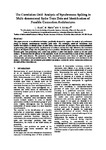The correlation grid: analysis of synchronous spiking in multi-dimensional spike train data and identification of feasible connection architectures
| dc.contributor.author | Stuart, EJ | |
| dc.contributor.author | Walter, M | |
| dc.contributor.author | Borisyuk, Roman | |
| dc.date.accessioned | 2017-02-20T14:01:04Z | |
| dc.date.available | 2017-02-20T14:01:04Z | |
| dc.date.issued | 2005 | |
| dc.identifier.issn | 0303-2647 | |
| dc.identifier.issn | 1872-8324 | |
| dc.identifier.uri | http://hdl.handle.net/10026.1/8545 | |
| dc.description.abstract |
This paper presents a visualization technique specifically designed to support the analysis of synchronous firings in multiple, simultaneously recorded, spike trains. This technique, called the correlation grid, enables investigators to identify groups of spike trains, where each pair of spike trains has a high probability of generating spikes approximately simultaneously or within a constant time shift. Moreover, the correlation grid was developed to help solve the following reverse problem: identification of the connection architecture between spike train generating units, which may produce a spike train dataset similar to the one under analysis. To demonstrate the efficacy of this approach, results are presented from a study of three simulated, noisy, spike train datasets. The parameters of the simulated neurons were chosen to reflect the typical characteristics of cortical pyramidal neurons. The schemes of neuronal connections were not known to the analysts. Nevertheless, the correlation grid enabled the analysts to find the correct connection architecture for each of these three data sets. | |
| dc.format.extent | 223-233 | |
| dc.format.medium | ||
| dc.language | eng | |
| dc.language.iso | eng | |
| dc.subject | information visualisation | |
| dc.subject | data analysis | |
| dc.subject | spike trains | |
| dc.subject | synchrony | |
| dc.subject | cross-correlogram | |
| dc.subject | correlation grid | |
| dc.title | The correlation grid: analysis of synchronous spiking in multi-dimensional spike train data and identification of feasible connection architectures | |
| dc.type | journal-article | |
| dc.type | Journal Article | |
| dc.type | Research Support, Non-U.S. Gov't | |
| plymouth.author-url | https://www.webofscience.com/api/gateway?GWVersion=2&SrcApp=PARTNER_APP&SrcAuth=LinksAMR&KeyUT=WOS:000226573200026&DestLinkType=FullRecord&DestApp=ALL_WOS&UsrCustomerID=11bb513d99f797142bcfeffcc58ea008 | |
| plymouth.issue | 1-3 | |
| plymouth.volume | 79 | |
| plymouth.publication-status | Published | |
| plymouth.journal | BIOSYSTEMS | |
| dc.identifier.doi | 10.1016/j.biosystems.2004.09.011 | |
| plymouth.organisational-group | /Plymouth | |
| plymouth.organisational-group | /Plymouth/Faculty of Science and Engineering | |
| plymouth.organisational-group | /Plymouth/Faculty of Science and Engineering/School of Engineering, Computing and Mathematics | |
| plymouth.organisational-group | /Plymouth/REF 2021 Researchers by UoA | |
| plymouth.organisational-group | /Plymouth/REF 2021 Researchers by UoA/UoA11 Computer Science and Informatics | |
| plymouth.organisational-group | /Plymouth/Users by role | |
| plymouth.organisational-group | /Plymouth/Users by role/Academics | |
| plymouth.organisational-group | /Plymouth/Users by role/Researchers in ResearchFish submission | |
| dc.publisher.place | Ireland | |
| dc.identifier.eissn | 1872-8324 | |
| dc.rights.embargoperiod | Not known | |
| rioxxterms.versionofrecord | 10.1016/j.biosystems.2004.09.011 | |
| rioxxterms.licenseref.uri | http://www.rioxx.net/licenses/all-rights-reserved | |
| rioxxterms.type | Journal Article/Review | |
| plymouth.funder | Cross-modality integration of sensory signals leading to initiation of locomotion::BBSRC |


